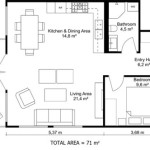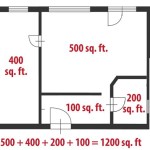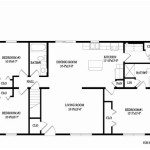Understanding Measurement Used In Floor Plans
Floor plans are essential tools in architecture, interior design, real estate, and construction. They are scaled diagrams that depict the layout of a building or space from a bird's-eye view, showing the arrangement of rooms, walls, doors, windows, and other important features. Accurate measurements are the bedrock of any useful floor plan, enabling accurate construction, efficient space planning, and effective communication between stakeholders. Understanding the types of measurements used, the units employed, and the conventions followed is critical for interpreting and utilizing floor plans effectively.
The primary purpose of measurements in floor plans is to represent the real-world dimensions of the space in a scaled-down version. This allows architects, designers, and builders to visualize the spatial relationships between different elements and to calculate areas, volumes, and quantities of materials needed for construction or renovation. Furthermore, accurate measurements are crucial for ensuring that furniture, appliances, and other fixtures can be accommodated within the space.
Without accurate measurements, floor plans would be largely useless. Miscalculations could lead to costly errors in construction, such as walls being too short or rooms being the wrong size. They also enable the accurate calculation of material requirements, minimizing waste and keeping budgets under control. Consequently, attention to detail in measurement and a thorough understanding of the conventions used is indispensable for professional success in any field that relies on floor plans.
Units of Measurement: Feet, Inches, and the Metric System
Two primary systems of measurement are prevalent in floor plans: the Imperial system (using feet and inches) and the metric system (using meters and millimeters). The choice of system often depends on the geographical location, industry standards, and the preferences of the architect or designer.
In countries like the United States, the Imperial system remains the standard. Distances are typically expressed in feet and inches, with fractions of an inch sometimes used for greater precision. A typical dimension might be written as 12'-6", indicating 12 feet and 6 inches. Understanding how to convert between feet, inches, and fractions of an inch is essential for interpreting these measurements accurately. For instance, 1/2 inch, 1/4 inch, and 1/8 inch are commonly used to represent smaller increments.
The metric system, on the other hand, is widely used in most other parts of the world. It relies on meters as the base unit for length, with millimeters used for finer measurements. A dimension might be written as 3.8 meters or 3800 millimeters. The metric system's decimal-based structure simplifies calculations and conversions compared to the Imperial system. Conversion between meters and millimeters involves simply multiplying or dividing by 1000.
Regardless of the system used, it is crucial that the floor plan clearly indicates the units of measurement. This is usually done in a title block or legend on the drawing. Without this information, the measurements are meaningless and could lead to significant errors.
Occasionally, a floor plan might use a combination of systems, especially in international projects or when dealing with imported materials that are manufactured using one system while the construction is based on another. In such cases, clear labeling and conversion tables are essential to avoid confusion.
Types of Measurements: Interior, Exterior, and Overall Dimensions
Floor plans typically include several types of measurements that provide different levels of detail about the size and shape of the space. These measurements can be broadly categorized as interior dimensions, exterior dimensions, and overall dimensions.
Interior dimensions refer to the measurements of the rooms and spaces within the building. These measurements are usually taken from the inside faces of the walls, indicating the usable floor area within each room. Interior dimensions are critical for space planning, furniture placement, and determining the quantity of flooring materials needed. For example, the dimensions of a living room might be specified as 15'-0" x 20'-0", indicating that the room is 15 feet wide and 20 feet long from the inside faces of the walls.
Exterior dimensions, on the other hand, represent the measurements of the building's outer walls. These measurements are taken from the outside faces of the walls and are important for determining the building's footprint, its position on the site, and compliance with zoning regulations. Exterior dimensions also influence the amount of exterior cladding materials needed, such as siding or brick. For instance, the overall width of a house might be given as 30'-0", indicating the distance between the outside faces of the side walls.
Overall dimensions provide the total length and width of the building, including any overhangs, porches, or other projections. This is often indicated in a separate section of the floor plan or in the title block. Overall dimensions are useful for understanding the building's size in relation to the site and surrounding structures. These dimensions are commonly used for initial site planning and regulatory approvals.
It's important to note that wall thicknesses are usually not included in interior dimensions. The wall thickness will, however, affect the size of interior rooms. Floor plans that show both the interior and exterior dimensions can be very useful for calculating wall thicknesses and for verifying the overall accuracy of the drawing. Also, different types of walls have varying thicknesses. Exterior walls tend to be thicker than interior walls for insulation and structural reasons.
A clear distinction must be made between finished measurements and rough-in measurements. Finished measurements indicate sizes after all finishes (such as drywall, flooring, and trim) are installed. Rough-in measurements are used during the initial construction phase before finishes are applied. Knowing which type of measurement is being referenced is vital for accurate planning and materials procurement.
Scaling and Accuracy: Ensuring Reliable Measurements
Floor plans are almost always drawn to scale, meaning that the dimensions on the drawing are proportional to the real-world dimensions of the building. The scale is typically indicated on the floor plan, such as 1/4" = 1'-0" or 1:50. This notation means that every quarter inch on the drawing represents one foot in reality, or that one unit on the drawing represents fifty units in the real world, respectively. Understanding and applying the scale correctly is fundamental to accurately interpreting measurements from the floor plan.
To determine an actual dimension from a scaled drawing, one must measure the distance on the drawing and then multiply it by the scale factor. For example, if a wall measures 2 inches on a floor plan with a scale of 1/4" = 1'-0", the actual length of the wall would be 2 inches / (1/4 inch per foot) = 8 feet. Failure to properly apply the scale will invariably lead to inaccurate calculations and mistakes in construction or design.
The accuracy of measurements on a floor plan is paramount. Even small errors can accumulate and result in significant discrepancies during construction. Architects and designers use various tools and techniques to ensure accuracy, including computer-aided design (CAD) software, laser measuring devices, and careful attention to detail during the drafting process. The level of accuracy required will depend on the complexity of the project and the tolerances allowed by building codes. It's imperative that the floor plan clearly states the acceptable margin of error, particularly for critical dimensions.
Furthermore, the use of standard architectural symbols and conventions helps to minimize ambiguity and ensure that measurements are interpreted correctly. For instance, the placement of dimension lines, extension lines, and arrowheads follows well-established conventions that aid in clarity. Similarly, the use of consistent notation for doors, windows, and other features contributes to the overall accuracy and readability of the floor plan.
In cases where a high degree of precision is required, architects may provide detailed schedules that list specific dimensions and tolerances for various elements of the building. These schedules serve as a supplement to the floor plan and provide additional clarity where needed. They help to reduce ambiguity and prevent misunderstandings among the different trades involved in the project.
Regularly checking and verifying measurements throughout the design and construction process is essential. This can be done using physical measurements of the site and building components, as well as by comparing the floor plan against other construction documents, such as elevations and sections. These checks can help to identify and correct errors early on, before they become costly problems.

How To Read A Floor Plan With Dimensions Houseplans Blog Com
Display Outside Wall Measurements On 2d Floor Plans Roomsketcher Help Center

Floor Plans With Dimensions Including Examples Cedreo

The 7 Measurement Types In Roomsketcher

How To Read A Floor Plan With Dimensions Houseplans Blog Com

How We Work Detailed Floor Plan Drawings

Floor Plans With Dimensions Including Examples Cedreo

How To Read A House Plan With Dimensions Riverfront Custom Homes

How To Read A Floor Plan With Dimensions Houseplans Blog Com

How To Read Floor Plans 8 Key Elements A Plan Foyr
Related Posts








